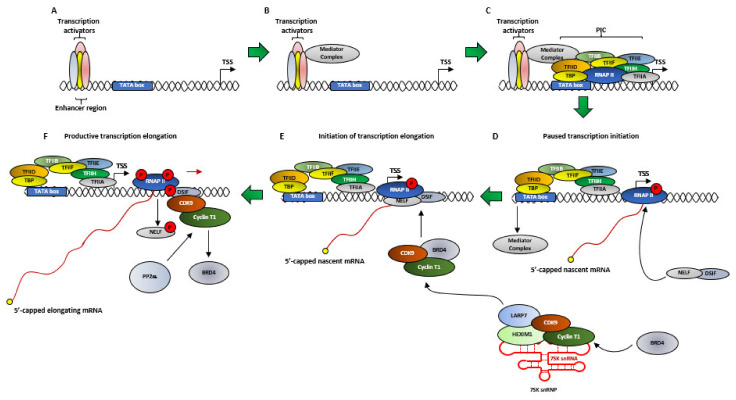Figure 4.
The simplified model of the regulation of transcription by P-TEFb. (A) At the beginning of transcription, Transcription Factors (TFs) bind to the enhancer regions, upstream of the core promoter region (represented by the TATA box). The TATA box in-turn is located upstream of the Transcription Start Site (TSS). (B) TFs recruit the Mediator Complex (MC) (Simplified here from Figure 3). (C) The MC then assists in the recruitment and assembly of the PIC on the DNA strand which, as mentioned before, starts promoter melting and form the transcription bubble, to allow to the RNAP II to access the DNA template strand. (D) The TFIIH subunit of PIC also phosphorylates the S5 residue at the CTD of RNAP II to initiate transcription from the TSS to generate a nascent mRNA transcript of ~50 ribonucleotides but pauses due to recruitment of two negative regulators of transcription DSIF and NELF. The S5 phosphorylation also enables the dissociation of the MC and freeing-up of the RNAP II from the PIC and promotes the recruitment of capping enzymes to cap the 5′-end of the nascent mRNA strand in a multi-step process, to prevent the nascent strand from being degraded by nucleases like XRN2. The cap remains until transcription finishes and the mRNA is properly processed. (E) When it is ideal for the cells to carry-out productive transcription, BRD4 recruits P-TEFb (CDK9/Cyclin T1) from its negative regulatory complex—7SK snRNP to the RNAP II. However, the kinase activity of the BRD4 bound CDK9 remains transiently inhibited due to the phosphorylation of T29 of CDK9 by BRD4 (F) The phosphatase PP2α is then recruited which dephosphorylates T29, restoring the kinase activity of CDK9. This causes the additional P-TEFb mediated phosphorylations of RNAP II at S2, the SPT5 subunit of DSIF at T4 and NELF. This allows NELF to dissociate from RNAP II, which along with SPT5 phosphorylation, transforms DSIF to a positive elongation factor. These events relieve RNAP II from transcription pause and allows it to progress along with the DNA template to initiate productive transcriptional elongation. As the transcription elongation gears-up, BRD4 was released from the P-TEFb.

